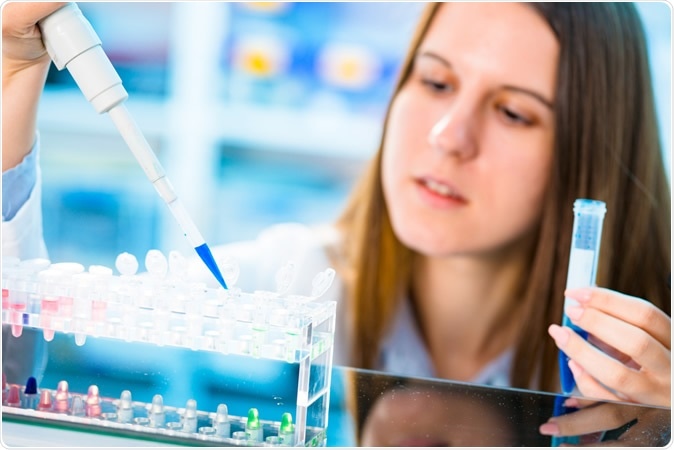The heart of modern therapy is increasingly personalized and targeted at specific cellular or genetic deficits. This requires gene therapy, in many cases. A new study, published on 19 September 2019 in the journal Nature, describes an improved way to produce purified gene carrier viruses called AAVs cheaply and quickly, from the culture medium. One striking application of this therapy has already been approved in the form of the agent called Zolgensma, used to treat the incurable neurological condition called spinal muscular atrophy (SMA). This modified gene is inserted into the host cells by an AAV. Not only is the output much larger, but the cell culture input is five times less. This could make it much easier to develop gene-based medicine by providing access to inexpensive and pure AAV preparations.

Image Credit: Science photo / Shutterstock
What are AAVs?
For many areas in modern biomedical research, gene transfer and expression in living cells or organisms is increasingly vital. For this purpose, the use of adeno-associated viruses (AAVs) has become standard. An AAV is a small virus belonging to the parvovirus family, with a single strand of DNA, which naturally incorporates its genome into chromosome 19, at a site called the AAVSI site, of the human genome following infection. However, the modified AAVs that contain the extra or modified genes that are used in gene therapy or research do not fuse their nucleic acid with the host genome. Instead they deliver their genetic wares in the form of a separate circular molecule of genetic matter, consisting of multiple copies of the viral genome, joined end-to-end, inside the nucleus. This episome, as it is called, stays intact within mature non-dividing cells for months on end, expressing the desired characteristic.
AAVs are commonly used in gene research and therapy due to a number of advantages: the high efficiency with which genes are transferred, the low immune response, the stable level of gene expression over the long term, and selectivity for specified tissues. Thus this is far superior to older gene transfer techniques such as transgenic and conditional knockout animals, when used in combination with other powerful and selective gene editing tools like CRISPR. This can save time and reduce the number of animals needed for research. This will cut the costs of traditional gene manipulation studies and make it easier to progress towards preclinical gene therapy trials.
The problem
One of the biggest obstacles that still stands in the way of universal adoption of AAV is the difficulty of purifying AAVs and the low viral amounts obtained.
AAVs are produced inside infected cells but this requires a helper virus, as it lacks the essential genetic matter to initiate its own reproduction. However, helper viruses make it difficult to purify the final product, but also induce inflammation or other unwanted side effects in the host if not removed. As a result, plasmids are used instead, which contain genes like E2A and E4 that promote the replication of the AAV. This plasmid-AAV system is set up in human embryonic kidney (HEK) 293T cells, which supply other required proteins, forming a helper-free production framework. Three plasmids are included, namely, pHelper, AAV trans-plasmid and AAV cis-plasmid which code for all the genetic machinery required for gene transcription.
Even then, current methods grow the AAVs inside producer cells in stacks or cell culture factories, which are then lysed to provide adequate amounts of AAVs. The problem is that the culture medium also contains a lot of AAV which is wasted.
The new protocol
The current technique sought to purify AAVs from both producer cells and culture medium in a more efficient manner.
The researchers found that using HEK293T cells with lower levels of glucose reduced the acid level in the culture medium which positively affects viral replication. Glutamine supplementation is also critical as glutamine feeds the cell and increases virus production. Purification of the AAV sample obtained from the previous steps using discontinuous iodixanol gradient delivered a preparation of above 90% purity. Impure preparations can cause inflammation and also cause unwanted production of host proteins. Thus this final purification is required for AAVs that are suitable for use in living cells or systems.
The yield of AAVs with this protocol is high, at 1010–1011 vg/µl, while the whole process takes only seven days from beginning (transfection of HEK cells to final viral suspension for use).
A pilot study using AAVs prepared by this technique showed a very high rate of effect in the treated mice compared to a control group injected with another strain of AAV. Using specific promoter gene segments can also help target the desired tissue or cell type more efficiently and specifically. This rapid and sophisticated method of AAV production and purification allows gene transduction both in vitro and in vivo. It also improves the purity of the final viral suspension, reduces the inflammation, and produces a more efficient response.
Researcher Reiko Matsui says, “Several labs in the Boston area and Japan have already tested this new protocol and found it useful. Our hope is that many laboratories can adapt these procedures to accelerate research and promote gene therapy.”
Journal reference:
Production of adeno-associated virus vectors for in vitro and in vivo applications. Toyokazu Kimura, Beatriz Ferran, Yuko Tsukahara, Qifan Shang, Suveer Desai, Alessandra Fedoce, David Richard Pimentel, Ivan Luptak, Takeshi Adachi, Yasuo Ido, Reiko Matsui & Markus Michael Bachschmid. Scientific Reports, volume 9, Article number: 13601 (2019). https://doi.org/10.1038/s41598-019-49624-w. https://www.nature.com/articles/s41598-019-49624-w#article-info